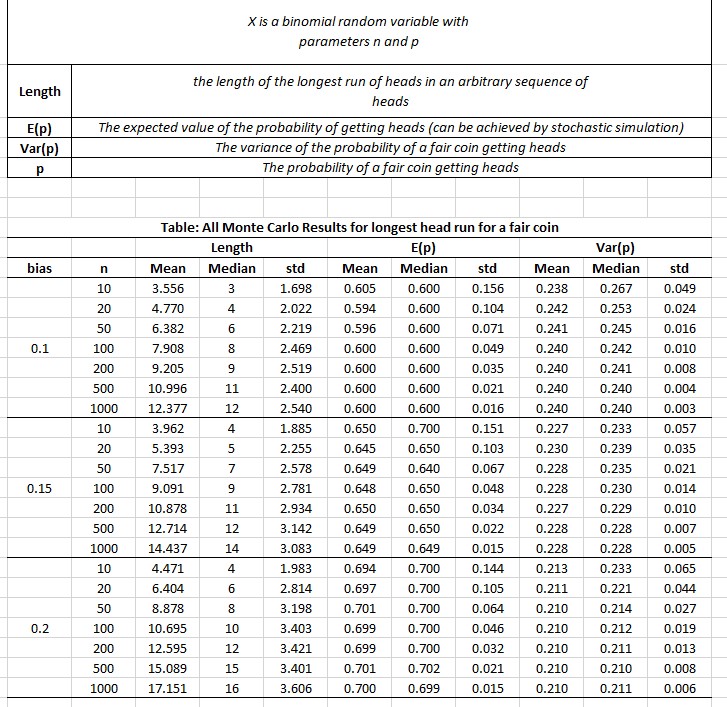% % LongestrunofHeads
clear; close; clc;
In a (fair) coin toss experiment, the coin is tossed n times. The result is a series of heads (H) and tails (T). A subsequence of consecutive heads (tails) is called heads (tails): Sequence 1: THHHHTTTTHHHHTTTTHHHHTH... Sequence 2: THTHTTTHTTTTTHTHTTTHTTH... from https://www.maa.org/sites/default/files/images/upload_library/22/Polya/07468342.di020742.02p0021g.pdf we analyze which of the sequences is more likely to have arisen from actual coin tossing and which one is the imposter?
% We solve this famous problem from Davidson, R., & MacKinnon, J. G. (1993) % Estimation and inference in econometrics (Vol. 63). New York: Oxford: % "A well-worn example of a nonstochastic probability limit is given by % considering the limit of the sequence of proportions of heads in a series % of independent tosses of an unbiased coin. It is worth demonstrating % formally that the probability limit is indeed one-half, since this will % give us the opportunity to see some useful techniques of proof and % acquire some intuition about how probability limits differ from ordinary % ones."
tic rng(729183,'multFibonacci') % Control random number generator
Our aim is show the convergence in probability of  to 1/2 for a unbiased coin:
to 1/2 for a unbiased coin:

In case of biased coin, this plim is unvalid.
n=[10 20 50 100 200 500 1000]; % number of trials p=0.5; % probability of heads(tails) bias=[-0.2 -0.15 -0.1 -0.05 0 0.05 0.1 0.15 0.2]; % we inject bias MC=1000; % the number of Monte carlo simulation experiments nn=size(n,2); Seq=cell(nn,1); % sets of random sequences of heads and tails for any value of n. longest=zeros(nn,MC); theLength=zeros(nn,3); % the length of the longest run of heads in an arbitrary sequence of heads and tails. Mu_mc=zeros(nn,MC);Var_mc=zeros(nn,MC); theMu=zeros(nn,3);theVar=zeros(nn,3); bb=size(bias,2); sonuc=cell(bb,3); for b=1:bb for j=1:nn trial=zeros(n(j),1); for i=1:n(j) trial=rand(i,MC)<(bias(b)+p); end Seq{j,1}=double(trial); for mc=1:MC if Seq{j,1}(:,mc)==0 longest(j,mc)=0; else longest(j,mc)=max(accumarray(nonzeros((cumsum(~Seq{j,1}(:,mc))+1).*Seq{j,1}(:,mc)),1)); end Mu_mc(j,mc)=mean(Seq{j,1}(:,mc)); Var_mc(j,mc)=var(Seq{j,1}(:,mc)); end theLength(j,:)=[mean(longest(j,:)) median(longest(j,:)) std(longest(j,:))]; theMu(j,:)=[mean(Mu_mc(j,:)) median(Mu_mc(j,:)) std(Mu_mc(j,:))]; theVar(j,:)=[mean(Var_mc(j,:)) median(Var_mc(j,:)) std(Var_mc(j,:))]; end sonuc{b,1}=theLength; sonuc{b,2}=theMu; sonuc{b,3}=theVar; end Sonucxlsx=cell2mat(sonuc) ; % All outcomes of the Monte Carlo Simulation values toc
Elapsed time is 167.833585 seconds.


